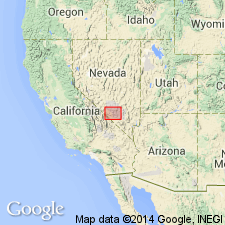
- Usage in publication:
-
- Bullfrog Member*
- Modifications:
-
- Named
- Dominant lithology:
-
- Tuff
- AAPG geologic province:
-
- Great Basin province
Summary:
Named as the basal member of the newly named Crater Flat Tuff for exposures at Bullfrog Mountain, western Nye Co, NV in the Great Basin province. Type locality exposed on mountain north of Bullfrog mine, Bullfrog quad, NV. Formerly called cooling unit 2 of Bullfrog Hills caldera. Is 130 m on Crater Flat. May locally be as much as 180 m thick. Exposures are incomplete, so total maximum thickness unknown. Probably covered a larger area than now known. Shown on distribution map from Lincoln Co across Nye Co into NV into Inyo Co, CA. Erupted from the Sleeping Butte caldera. Is conformable on unnamed bedded ash-fall tuff, or on an unnamed bedded tuffaceous sandstone. Overlain by breccia, lava flow, or by bedded tuff of the Crater Flat. Has a feldspar compositional zonation with plagioclase in excess of alkali feldspar in lower part and feldspar subequal in upper part. Is an ash-flow sheet that may be brown and glassy, or gray, mottled yellow and brown, and microcrystalline from base to top. The common biotite flakes in small (1-3 cm) white pumice lenticles and the visible quartz phenocrysts distinguish this member from other units. Modal analyses and silica range diagram. Miocene age. Has K-Ar age of 14.0 and 13.0 m.y.; 14 m.y. thought to be the most reliable date. Has normal remanent magnetism.
Source: GNU records (USGS DDS-6; Denver GNULEX).
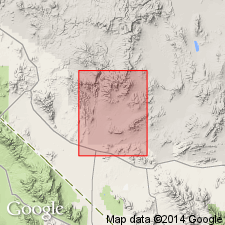
- Usage in publication:
-
- Bullfrog Member*
- Modifications:
-
- Overview
- AAPG geologic province:
-
- Great Basin province
Summary:
Mapped in exposures as the middle member of Crater Flat Tuff in south central part of area east and south of Little Skull Mountain, and in northwest part of area near Prow Pass, and in subsurface in cross section, Nye Co, NV in the Great Basin province. Is an ash-flow tuff and a compound cooling unit. Divisible into three subunits. Lower subunit is partly to densely welded, orange, gray, brown devitrified, contains quartz, potassium feldspar, plagioclase, hornblende, biotite, sparse volcanic and red-brown mudstone lithic inclusions. Middle subunit is partly welded, devitrified, brown, orange, contains quartz, potassium feldspar, plagioclase, hornblende, biotite, gray volcanic lithic fragments, thin reworked tuff at base. The upper subunit is nonwelded, red-brown to red-orange, devitrified, contains quartz, potassium feldspar, plagioclase, biotite and hornblende, brown-gray volcanic lithic inclusions. Reworked tuff about 10 m thick at base. Maximum exposed thickness: 90+/-m; in subsurface 131 m thick. Overlies Tram Member of Crater Flat. Underlies Prow Pass Member of Crater Flat. Normal magnetic polarity. Miocene age.
Source: GNU records (USGS DDS-6; Denver GNULEX).
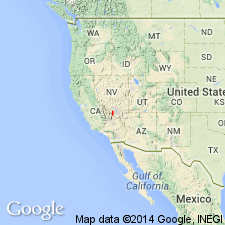
- Usage in publication:
-
- Bullfrog Member*
- Modifications:
-
- Revised
- Geochronologic dating
- AAPG geologic province:
-
- Great Basin province
Summary:
Previously thought to be the lower member of Crater Flat Tuff. Recognized in this report as the middle member (of 3) of Crater Flat. The upper member is the Prow Pass Member. The lower, petrologically similar tuff of the Crater Flat is named the Tram Member. The Bullfrog has about the same distribution as the Tram. Upper and lower parts of the Bullfrog are nonwelded to partially welded, zeolitic tuff; and central zone (100 to 300 feet) is a moderately to densely welded tuff. Petrographically, Bullfrog contains twice as much plagioclase as alkali feldspar, and about 10 to 25 percent of the phenocrysts are quartz. Quartz is moderately to strongly resorbed. Mafic minerals are biotite and subordinate hornblende. Age of Bullfrog Member is considered 13.5 Ma. Is average of previously determined ages of 14 Ma, based on K-Ar dating on biotite (citing Marvin and others, 1970), and 13 Ma, based on K-Ar dating on sanidine (citing Marvin and others, 1970; Byers and others, 1976). Areal extent map shows Bullfrog possibly present in southern Nye County, Nevada, southwest Lincoln County, Nevada, and eastern Inyo County, California. Report includes geologic map, stratigraphic chart.
Source: GNU records (USGS DDS-6; Denver GNULEX, Menlo GNULEX).
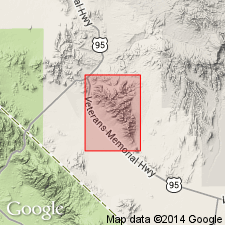
- Usage in publication:
-
- Bullfrog Member*
- Modifications:
-
- Areal extent
- Age modified
- AAPG geologic province:
-
- Great Basin province
Summary:
Bullfrog Member of Crater Flat Tuff geographically extended into report area [Bare Mountain, Nye Co, NV]. Unit age in area of report revised from Miocene to middle Miocene based on revised age for the Crater Flat Tuff, locally.
Source: GNU records (USGS DDS-6; Menlo GNULEX).
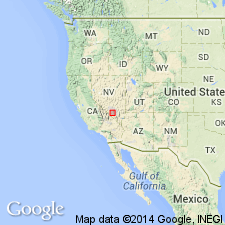
- Usage in publication:
-
- Bullfrog Tuff*
- Modifications:
-
- Revised
- Geochronologic dating
- AAPG geologic province:
-
- Great Basin province
Summary:
Within southwest Nevada volcanic field, Nye Co, NV, Great Basin province, units previously of formation rank are raised to group rank to allow for combining petrographically, geochemically, and temporally related lava flows and nonwelded tuffs with the principal correlative welded ash-flow tuff sheets (formerly members of the previous formation-rank tuffs). The ash-flow sheets are raised to formation rank and designated as "Tuff." Bullfrog is middle of three formally named formations of Crater Flat Group (rank raised). [Crater Flat also consists of informal units not discussed in this report.] In this report Bullfrog includes Stockade Wash Tuff which is considered a correlative to Bullfrog. At Yucca Mountain Stockade Wash and Bullfrog may be separate outflow lobes of a composite ash-flow sheet and represent slightly different parts of the compositional zonation in a single magma chamber. Area 20 caldera is source of Bullfrog. Younger than Tram Tuff (rank raised) of Crater Flat; older than Prow Pass Tuff (rank raised) of Crater Flat. Nomenclature shown on table 1. 40Ar/39Ar dates from an average of 2 sanidine samples yielded an age of 13.2 +/-0.03 Ma (Miocene).
Source: GNU records (USGS DDS-6; Denver GNULEX).
For more information, please contact Nancy Stamm, Geologic Names Committee Secretary.
Asterisk (*) indicates published by U.S. Geological Survey authors.
"No current usage" (†) implies that a name has been abandoned or has fallen into disuse. Former usage and, if known, replacement name given in parentheses ( ).
Slash (/) indicates name conflicts with nomenclatural guidelines (CSN, 1933; ACSN, 1961, 1970; NACSN, 1983, 2005, 2021). May be explained within brackets ([ ]).

